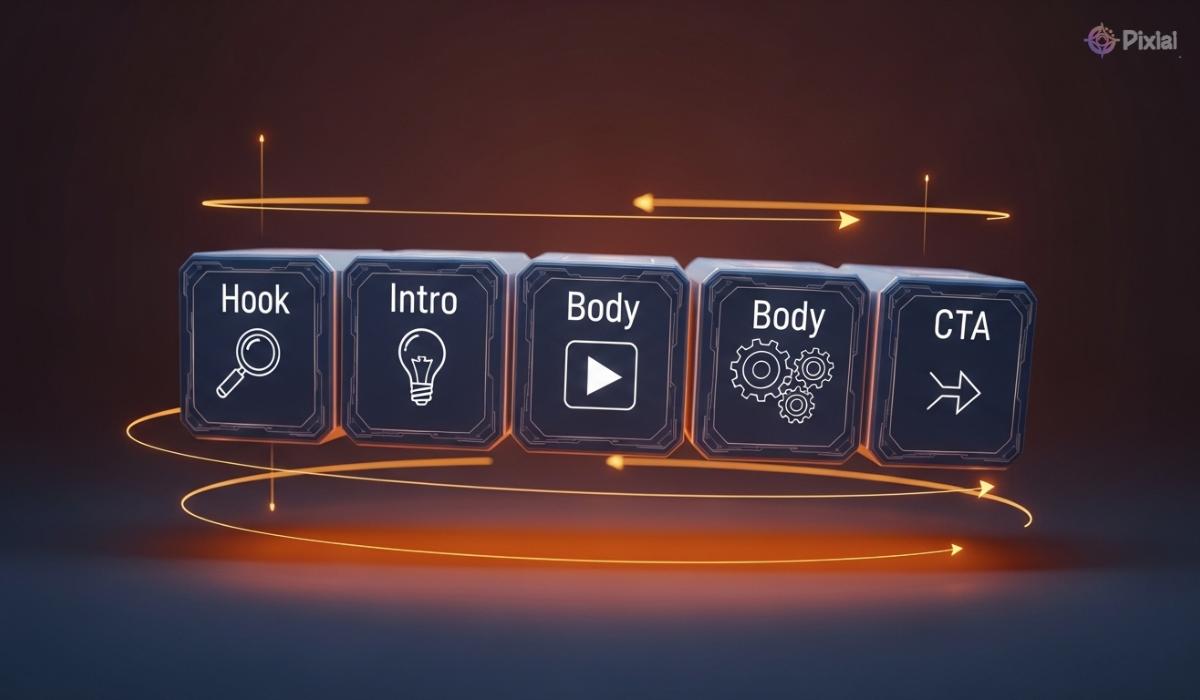By the end of 2025, industry analysts project that over a billion marketing videos will be generated by AI!
But industry data reveals a shocking truth: nearly 70% of them fail to engage viewers past the first 8 seconds. The reason isn’t the AI—it’s a weak script.
In the rapidly evolving world of artificial intelligence, the script is no longer just a collection of words.
It’s the source code, the directorial command, and the emotional core all rolled into one.
A powerful script is the absolute foundation of a successful, high-performing AI-generated video.
It’s the difference between a video that gets skipped and one that gets shared.
Forget everything you think you know about writing. This guide will provide a step-by-step blueprint specifically designed for AI.
You can learn how to write engaging, conversion-friendly scripts that command the AI to produce incredible results.
Table of Contents
| Sections | Key Findings |
| What is AI Video Generation? | AI turns your text-based script into a complete video, making the script’s quality paramount. |
| Why the Script is Everything | The script dictates the video’s tone, pacing, and clarity; a small change can triple engagement. |
| Audience and Goal Alignment | A winning script starts by defining who you’re talking to and what action you want them to take. |
| The Ideal AI Video Script Structure | A proven 4-part structure (Hook, Intro, Body, CTA) ensures your message is delivered effectively. |
| Tone, Style & Language Tips | Short sentences, a conversational tone, and formatting cues make AI voices sound more natural. |
| Common Scriptwriting Mistakes | Long paragraphs and a lack of visual direction are the most common errors that ruin AI videos. |
| Using AI to Optimize Scripts | Tools like ChatGPT can brainstorm ideas, while Grammarly can refine the tone for clarity. |
| The Perfect Script Template | A ready-to-use template provides a clear framework for writing your first AI video script. |
| Advanced Scriptwriting Tips | Incorporating storytelling arcs and data will elevate your AI videos from good to unforgettable. |
What is AI Video Generation (And Why Your Script is its Brain)?
At its core, AI video generation is a groundbreaking technology that automatically creates complete video content directly from a text script.
You provide the words, and the AI handles the rest—synthesizing a voiceover, selecting or creating relevant visuals, adding animations, and timing it all together.
Platforms like Synthesia, Pictory, and our own integrated suite at Pixi AI are at the forefront of this revolution.
While traditional video editing requires painstaking manual work for every second of footage, AI generation automates the entire production line.
But this automation comes with a critical condition: it needs perfect instructions.
Think of it this way: your script is the brain, and the AI is the body. The AI follows your words literally, precisely, and without interpretation.
Garbage in, garbage out. A vague, poorly structured script will always produce a confusing, robotic video. A sharp, intentional script, however, empowers the AI to create something truly compelling.
The Script is King: The Undeniable Link Between Words and Video Quality
A well-written script for AI video directly impacts every aspect of the final product’s quality. The tone, pacing, visual flow, and emotional resonance are all born from the words on the page.
Consider this simple example:
Weak Script: “Our product helps you be more efficient. It has many features that save you time. You should check it out.”
- Resulting AI Video: Monotone narration, generic stock footage of offices, and a weak call-to-action. Viewer engagement plummets.
Strong Script: (Energetic tone) “Are you tired of losing hours to tedious tasks? [pause 1s] Imagine reclaiming your entire afternoon. Our software automates your workflow in three simple clicks. [VISUAL: A quick 3-step animation] See for yourself.”
- Resulting AI Video: A dynamic voiceover with intentional pauses, specific and relevant visuals, and a clear, urgent CTA. Viewer engagement soars.
The visuals are identical, but the script transforms the video from boring to brilliant. That is the power you hold as the scriptwriter.
Before You Write a Single Word: Define Your Audience and Goal

The most common mistake in scriptwriting is starting with what you want to say instead of who you’re saying it to and why. Before you write a single word, answer these two questions:
- Who is my Target Viewer? Are you talking to busy marketing managers who value efficiency? Curious students looking for clear explanations? Potential customers on the fence about a purchase? Defining your persona dictates your language, tone, and examples.
- What is the Single Goal of this Video? Every video must have one primary objective. Is it to drive traffic, educate the audience, build brand awareness, or generate a sale? This goal will shape your entire script.
Use the Viewers’ Intent → Script Structure → CTA Alignment framework. Understand what your viewer wants, structure your script to deliver it, and align your Call-to-Action with your business goal.
For a deeper dive into video objectives, explore our suite of AI Marketing Tools designed to help you plan your campaigns.
The Perfect Structure for Any AI Video Script

After analyzing thousands of high-performing AI-generated videos, a clear 4-part structure emerges. It’s simple, effective, and designed for modern attention spans.
A. The Hook (First 10 Seconds): Seize Their Attention
You have less than 10 seconds to stop the scroll. Your hook must be powerful and concise.
Start with a shocking statistic, a thought-provoking question, or a bold statement that directly addresses a viewer’s pain point.
- Example: “Did you know that 80% of businesses are overpaying for their software? Here’s how to find out if you’re one of them.”
B. The Introduction (10-30 Seconds): Set the Stage
Once you have their attention, immediately tell them what they’re going to get. Briefly introduce the topic and promise a clear benefit or solution. This builds trust and gives them a reason to keep watching.
- Example: “In the next 60 seconds, I’ll show you the three hidden costs to look for and a simple tool to cut your expenses today.”
C. The Main Content (30-90 Seconds): Deliver the Value
This is the core of your video. Break your main point into 2-3 simple, digestible steps or ideas. Each point should be a new line in your script to ensure clear pacing. Focus on clarity and value. Don’t try to cram too much information in.
- Example: “First, check your subscription for auto-renewals… Second, look for per-user fees… And third, analyze your usage data…”
D. The Call-to-Action (Final 10-15 Seconds): Guide Their Next Step
End with a single, clear, and direct instruction. Tell the viewer exactly what you want them to do next. A video without a CTA is a missed opportunity. Making your CTA compelling is essential if you want to drive results, a key factor when you plan to monetize your AI-generated videos.
- Example: “Ready to start saving? Click the link below to get your free software audit now.”
Writing for an AI’s Voice: Tone, Style & Language Tips
Writing for an AI voice is different from writing for a human. AI narrators are incredibly precise, but they need clear instructions to sound natural. Here’s how to write a script for an AI voice that sounds human:
-
- Keep Sentences Short: Aim for under 15 words per sentence. This improves clarity and allows the AI to generate a more natural cadence.
- Use a Conversational Tone: Write as if you’re speaking to one person. Use contractions like “you’re” and “it’s” to make it feel more personal.
- Avoid Complex Jargon: Use simple, accessible language. If the AI struggles to pronounce a word, find a synonym.
- Add “Emotion Words”: Words like “amazing,” “powerful,” “frustrating,” or “simple” can subtly guide the AI’s inflection and tone.
- Use Formatting Cues: This is the secret weapon of professional AI scriptwriters. Use simple brackets to give the AI direct commands.
- [pause 1s] tells the AI to take a one-second breath, creating a dramatic effect.
- [emphasize this word] can prompt the AI to add stress to a specific word.
- (Upbeat tone) at the beginning of a line can set the mood for that sentence.
4 Common Scriptwriting Mistakes That Ruin AI Videos (And How to Fix Them)
These common pitfalls can turn a brilliant idea into a robotic, unwatchable video. Fortunately, they are incredibly easy to avoid once you know what to look for.
- The Wall of Text: Writing long, dense paragraphs. AI voices will read this as a monotonous block.
- Fix: Break your script into short, single-idea lines. One sentence per line is a great rule of thumb.
- Ignoring the Visuals: Writing only for the ear and forgetting the video component.
- Fix: Add simple visual cues in your script. Write [VISUAL: A chart showing growth] or [VISUAL: A person smiling while using a laptop]. This helps you visualize the final product and can guide AI tools that select stock media. For custom visuals, you can use tools like our AI Art Generator or AI Graphics Design to create exactly what your script calls for.
- Information Overload: Trying to cover five different topics in a 60-second video. This confuses the viewer and weakens your message.
- Fix: Dedicate one core idea to every 10-15 seconds of video. Be ruthless in cutting anything that doesn’t support your single video goal.
- The Dead End: A brilliant script that ends abruptly with no CTA. The viewer is engaged but has nowhere to go.
- Fix: Always, always include a clear directive at the end. Make it impossible for the viewer to misunderstand their next step.
Using AI to Write for AI: Script Optimization Tools
Leverage the power of AI to streamline your writing process. The modern workflow for an AI video script involves a stack of intelligent tools.
- Brainstorming & Drafting (ChatGPT, Jasper AI): Use generative AI to brainstorm ideas, create outlines, or even write a rough first draft. Use prompts like, “Write a 60-second video script for a marketing audience about the benefits of AI scriptwriting.”
- Refining Tone & Clarity (Grammarly, Quillbot): Paste your draft into these tools to check for grammatical errors, improve sentence structure, and refine your tone to be more conversational or professional.
- Direct Script-to-Video Generation (Pixi AI, Pictory, Synthesia): This is the final step. Once your script is polished, bring it to a dedicated video generator. With the Pixi AI Video Generator, you can simply paste your perfected script and watch the AI build your video in minutes.
Your Ready-to-Use AI Video Script Template
Here is a clear, copy-paste-friendly AI video script template to get you started.
Topic: How AI Can Save You Time in Marketing
[SCENE START]
(Upbeat, energetic tone) What if you could create an entire week’s worth of marketing videos… in just one hour? [pause 1s]
(Confident, clear tone) It sounds impossible, but with the power of AI video generators, it’s now a reality for businesses just like yours.
First, you save countless hours. No more filming, editing, or re-shooting. Just type. [VISUAL: A simple graphic showing a clock speeding up]
Second, you save thousands on costs. Access a full production studio right from your browser. [VISUAL: A graphic of a piggy bank growing larger]
And third, you unlock limitless creativity. Turn any idea into a polished video in minutes. [VISUAL: A lightbulb icon turning into a video play icon]
(Clear, direct tone) Ready to stop wasting time? Try the Pixi AI Video Generator today and turn your ideas into videos, instantly.
[SCENE END]
Advanced Scriptwriting: Storytelling, Data, and A/B Testing
Ready to level up? Go beyond the basic structure with these advanced techniques:
- Use Storytelling Arcs: Structure your script around a simple story: Problem (The old, slow way of doing things) → Discovery (Finding a new tool) → Solution (How the tool solves the problem) → Result (The amazing outcome).
- Weave in Data: Add credible statistics, data points, or short quotes to build authority and make your arguments more persuasive.
- A/B Test Your Scripts: Create two versions of your script with a different hook or CTA. Generate both videos and see which one performs better with your audience. For rapid iteration, you can even use real-time feedback tools to test prompts and concepts on the fly.
Conclusion: The Human Story Behind the AI Tool
A powerful AI video is not a product of the machine alone. It’s a collaboration. It begins with a smart, empathetic, and strategic script written by a human.
The AI is an incredibly powerful tool, but you are the director. You are the storyteller.
The technology is here, and it’s more accessible than ever. The barrier to entry for video creation has vanished.
Now, the skill that truly matters is the ability to write a script that can guide the AI to greatness.
The camera is now digital, and the actor may be an avatar, but the story is still yours to tell. Start writing your first AI video script today—and bring your vision to life.
